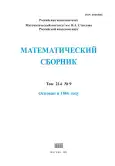Volume 214, Nº 9 (2023)
Billiard with slipping at any rational angle
Resumo
The class of billiards in a disc with slipping along the boundary circle by an angle commensurable with
 3-26
3-26


Construction of invariant Lyapunov norms of planar dynamical systems
Resumo
We consider the problem of the stability of linear dynamical switching systems. It is known that an irreducible
 27-57
27-57


Traces of Sobolev spaces to irregular subsets of metric measure spaces
Resumo
Given p∈(1,∞), let (X,d,μ) be a metric measure space with uniformly locally doubling measure μ supporting a weak local (1,p)-Poincaré inequality. For each θ∈[0,p) we characterize the trace space of the Sobolev W1p(X)-space to lower θ-codimensional content regular closed sets S⊂X. In particular, if the space (X,d,μ) is Ahlfors Q-regular for some Q≥1 and p∈(Q,∞), then we obtain an intrinsic description of the trace-space of the Sobolev space W1p(X) to arbitrary closed nonempty sets S⊂X.
 58-143
58-143


 144-160
144-160


Relative optimality in nonlinear differential games with discrete control
Resumo
Two control problems with an obstacle that is the second player in a differential game are considered. The dynamics in the first problem is described by a nonlinear system of differential equations of the first order, whereas the dynamics in the second is described by a nonlinear system of differential equations of the second order. A piecewise constant control with finite set of values is used. The control is aimed at moving arbitrarily closely to a finite trajectory described by an auxiliary control system of simple form, for any actions of the obstacle. For both problems phase constraints on the auxiliary system under which the control of the auxiliary system can be arbitrary are obtained. For any neighbourhood and any control of the auxiliary system satisfying these constraints, there are admissible controls in the original problems ensuring that at each moment of time the phase point of the original system is in the indicated neighbourhood of the corresponding phase point of the auxiliary system. Thus, in view of the above constraints, when the control of the auxiliary system is chosen to be optimal in a certain sense, the original system can move arbitrarily closely to such a solution of the auxiliary system for any actions of the obstacle.
 161-174
161-174










